Furlough: Rishi Sunak reveals replacement support scheme
- Published
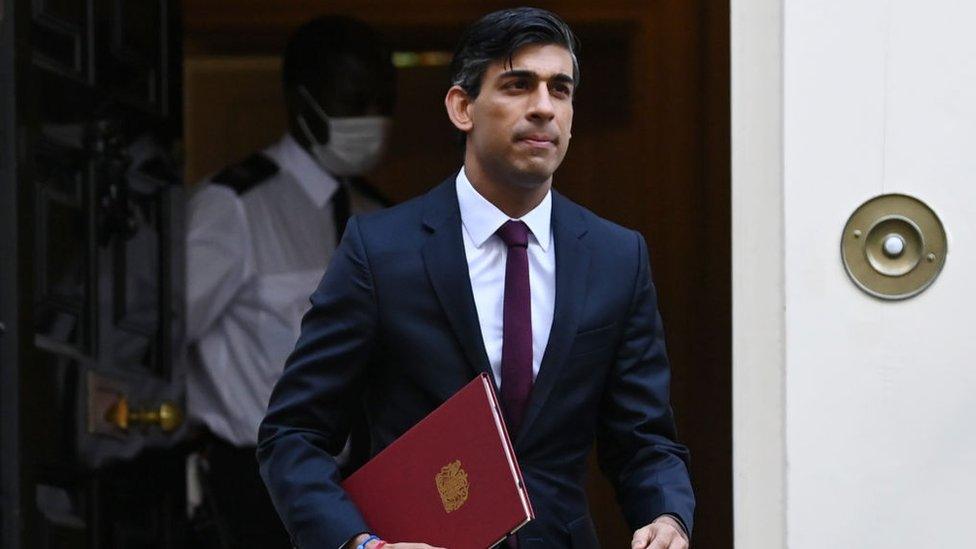
Chancellor Rishi Sunak has unveiled a new package to replace the furlough scheme
A new support scheme to replace furlough has been unveiled by the UK Chancellor Rishi Sunak.
It will mean thousands of people in Wales will be eligible for support - as long as they are in work for a least a third of their hours.
The government will then help top up wages, with companies asked to pay 55% of the bill.
The new emergency fund will be in place for six months, from 1 November.
The current furlough scheme comes to an end in October.
Mr Sunak said the furlough scheme would end because the support must "adapt and evolve".
He said no decision was harder but it was "fundamentally wrong" to keep people in unviable jobs.
"I can't save every job - no chancellor could," he told MPs as he unveiled details of the new Job Support Scheme.
Under the new scheme, a worker who does a minimum of 33% of their weekly hours will be guaranteed 77% of their weekly wage.
It would see the UK government paying a 22% slice of the bill - with firms paying the rest.
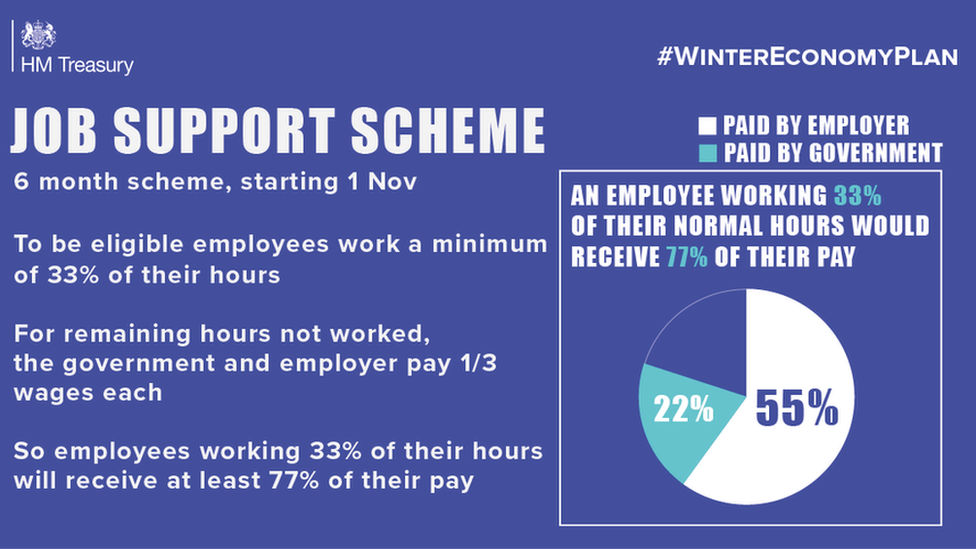
In addition to the furlough replacement, the chancellor announced that businesses borrowing money through the government's loan scheme would also be given more time to repay the money.
A VAT cut for hospitality and tourism companies will also be extended until March. The cut from 20% to 5% VAT - which came into force on 15 July - had been due to expire on 12 January next year.
Responding to the announcement, the business body CBI Wales welcomed the pledges.
"These bold steps from the Treasury will save hundreds of thousands of viable jobs this winter," said CBI Wales director Ian Price.
"The chancellor has listened to evidence from business and unions, acting decisively.
"It is this spirit of agility and collaboration that will help make 2021 a year of growth and renewal."
Businesses 'dangling off a cliff edge'
Peter Jones, who owns play centres in Aberbeeg, Blaenau Gwent, and in Caerphilly, said the furlough scheme was a "complete life-saver", but he had concerns over the new scheme.
Mr Jones has placed his 30 staff back on furlough, but is worried they will not be eligible for payments after the end of October as he will be unable to claim while his centres are closed.
"It is heart-breaking. It's a whole load of emotions we didn't think we were going to have to go through, here we are once again.
"It's going to give us some challenges and unless we reopen as we were, we are going to be left dangling off a cliff edge."
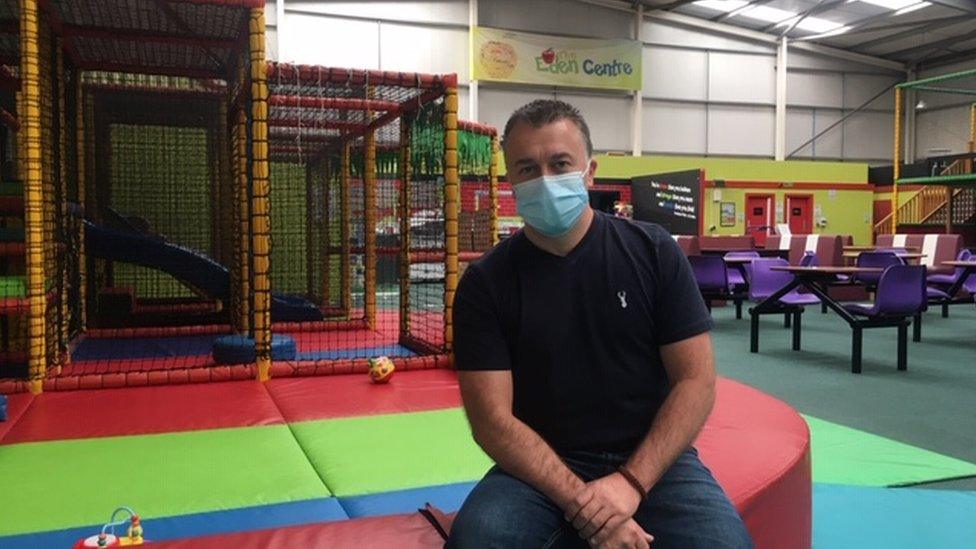
Peter Jones's 30 staff are currently on full furlough, but will not qualify for the replacement scheme if his play centres remain closed
Training and self-employed
Welsh Finance Minister Rebecca Evans said: "After pressing for further wage subsidy support, I welcome the Job Support Scheme but I am concerned that it is not coupled with new training investment.
"The chancellor has not provided extra support for our hardest-hit sectors such as steel and aerospace and today's package falls short on measures to support job creation."
Plaid Cymru has accused the chancellor of failing hundreds of thousands of workers, by not reviewing rules on the Self Employment Income Support Scheme, which is also being extended.
Ceredigion MP Ben Lake said too many were still being excluded: "We welcome this long-overdue measure to extend employment support. However, today's announcement will be no consolation to the 1.6 million self-employed people who have been left without a penny.
"The chancellor has been aware of the holes in his support schemes for months, yet he has unfortunately yet again refused to address those holes in his statement today."

What is furlough and why was it introduced?

High streets are still waiting to see shoppers return to pre-pandemic levels in Wales
The furlough scheme was designed to help people who couldn't do their jobs because of the pandemic and prevent mass redundancies.
Under the Coronavirus Jobs Retention Scheme, external, to give furlough its official title, workers placed on leave have been able to receive 80% of their pay, up to a maximum of £2,500 a month.
Since July, furloughed employees have been able to go back to work part-time. with the furlough scheme covering the other three days not worked.
Employers now have to pay 10% of the wages of furloughed workers, plus their National Insurance and pension contributions.
The scheme covers full-time, part-time, flexible, zero-hour and agency workers if they were on their employer's PAYE payroll on 19 March 2020.
Workers must be furloughed for at least three weeks, and can be furloughed more than once.
Companies can no longer make new furlough claims, except for people coming back from statutory parental leave or returning military reservists.
How popular has the scheme been?
The take-up has been significant, with 9.6 million workers furloughed by 1.2 million employers across the UK since March.
These employers had made £39.3bn of furlough claims by 20 September and the scheme will cost the government an estimated £60bn in total, less than the £80bn initially forecast.
Across the UK, the current percentage of eligible workers on furlough stands at 12%, according to the Office for National Statistics.
What was the picture in Wales?
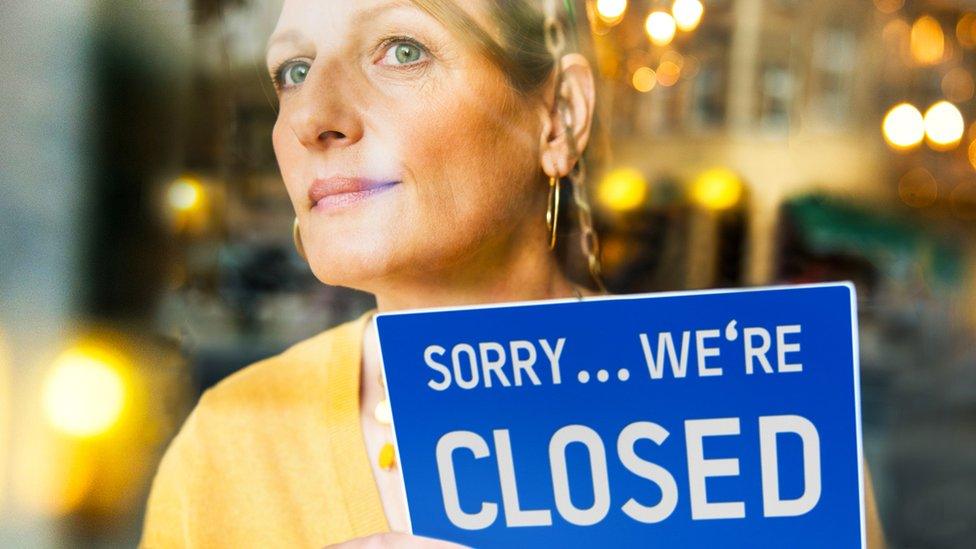
Furlough is meant to help businesses who cannot survive during the pandemic
By August in Wales, there were 401,000 workers on furlough, representing 31% of the eligible workforce across the country.
It means 50,000 people across Cardiff constituencies alone were taking part - or 29% of those eligible across the city.
In some areas, the percentage of workers being placed on furlough was even higher.
In Gwynedd's Dwyfor Meirionnydd constituency, covering holiday destination hotspots such as the Llŷn Peninsula, 41% of those eligible were placed on furlough.
It was a similar picture in Aberconwy, which includes the seaside town resort of Llandudno. It saw 38% of workers placed on the scheme.
It reflects a picture across the UK, which shows those in the food and accommodation sector were the hardest hit by the pandemic when it came to jobs.

Analysis: Sarah Dickins, BBC Wales economics correspondent
The latest official figures show 16% of businesses in the UK were still not trading in the last week of August and first week of September.
The study from the Office for National Statistics also shows that one quarter of accommodation and food businesses were at severe or moderate risk of insolvency - more than twice the rate for businesses as a whole.
The strongest economic recovery is being seen in the East Midlands and the weakest in London.
But shoppers still haven't returned to shops at levels experienced before covid.
High streets, retail parks and shopping centres only had 78% of the visitors they were seeing in February.
In Wales, in the week ending 20 September, fewer people visited shops than the week before.
The study also found that across the UK there are 8% fewer cars on the roads than in February.
- Published1 September 2020
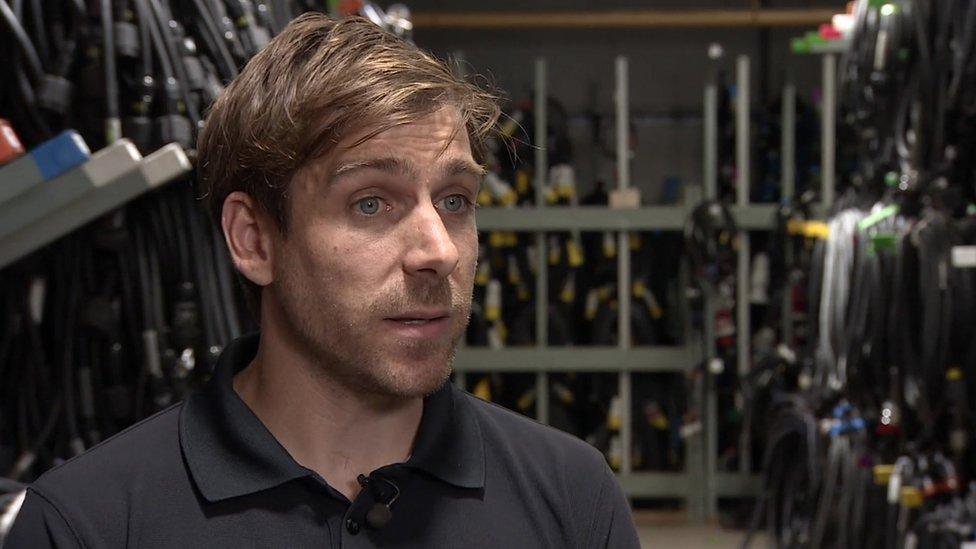
- Published17 September 2020

- Published11 June 2020

- Published6 June 2020
